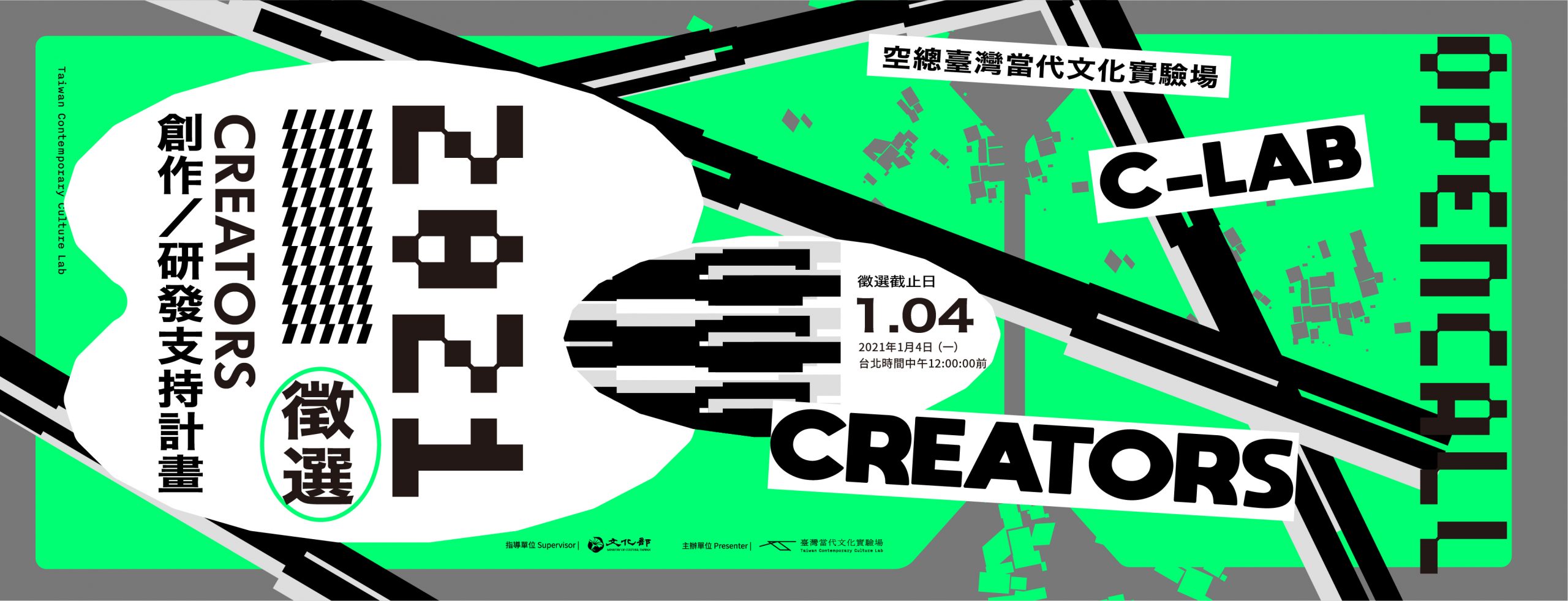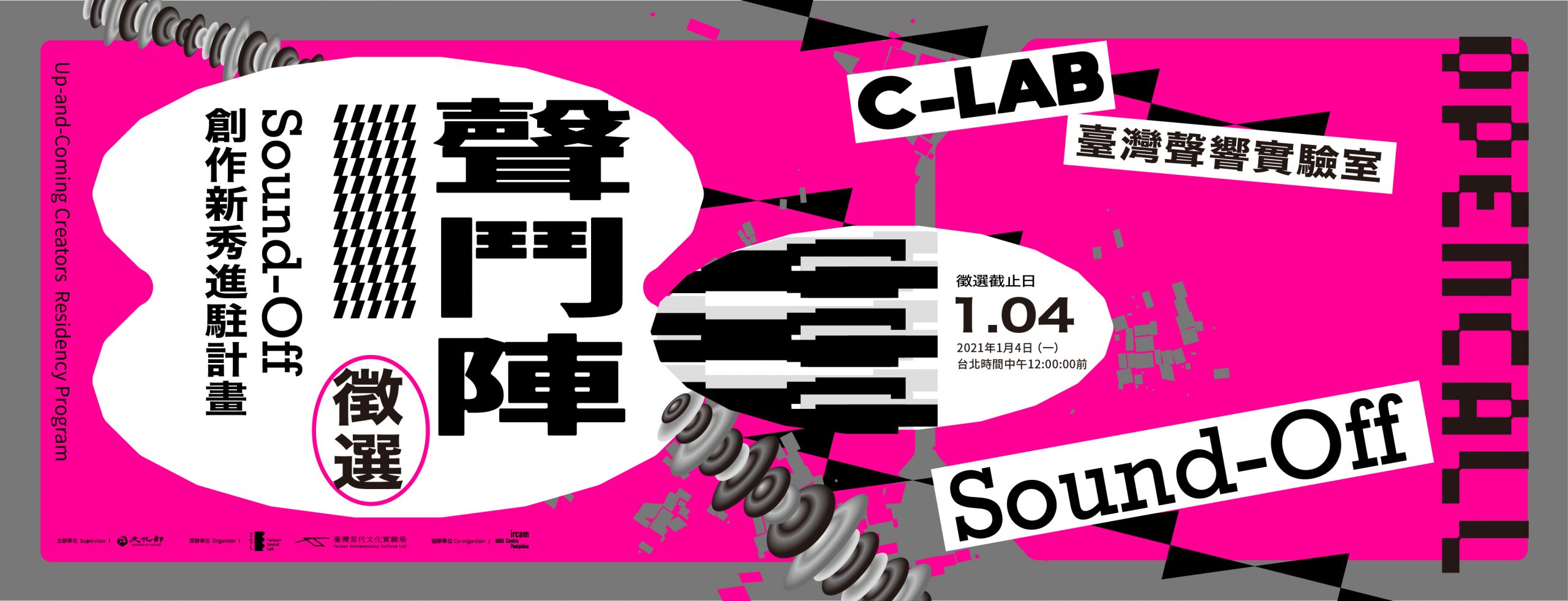In 2018, the Taiwan Contemporary Culture Lab (C-LAB) launched its CREATORS Creation/Research Support Program (CREATORS), and the program has now entered its fourth year as an incubator of cultural and artistic production. Welcoming proposals of cultural experimentation from all disciplines, C-LAB has nurtured the projects of over forty groups and individuals in the past years through the support of CREATORS. To encourage young talents in sound and music creation, C-LAB last year added to the program’s brand a new branch of its Taiwan Sound Lab: CREATORS Sound-Off: Up-and-Coming Creators Residency Program (Sound-Off). After two rounds of assessment by the review committee earlier this year, C-LAB last week announced the results of the open call for both programs for 2021.
This year (2021), the CREATORS program reviewed eighty-five applications, of which six were selected (a rate of 7%) to receive grants totaling NTD 4,000,000. The Sound-Off program considered sixteen applicants in the fields of new media, sound art, music performance, and composition, and one grantee was chosen after two rounds of in-depth discussion of the feasibility and artistic merits of the proposals.
The target applicants of the CREATORS program are cultural workers in general, and the grantees in the past years have ranged from artists, researchers, and curators to editors, social activists, and even nonprofitable organizations. CREATORS is distinguished from other residence and support systems in Taiwan by its very open spirit of operation. Most of the supported projects have not been short-term exhibitions or performances but were selected to encourage creative and cultural productions in their developing phase. CREATORS also eschews traditional results-oriented subsidies, much more strongly valuing the processes, and experiences of practitioners as well as the program’s public benefit. Sound-Off was founded to support sound creations and aims to promote young domestic creators through their collaborations with the Taiwan Sound Lab at C-LAB.
The grantees of the 2021 CREATORS program will enjoy a more generous residential period than in the past, with six to nine months of residence at C-LAB beginning March 1. In addition to providing grant support, C-LAB also continues its “accompanying observer” system, which pairs each grantee with an observer who provides in-depth feedback and discussions as the project develops. This system not only enables third-party observations but also creates records of the process of experimentation and development while documenting the professional knowledge production of each practice. The Sound-Off grantee also receives a residence of up to six months, beginning April 1, and a monthly allowance of NTD 30,000. During the residency, the grantee has access to the facilities and technologies of the Taiwan Sound Lab, which also provides technical assistance. C-LAB hopes that this program will offer state-of-the-art tools to creators and that the artist-in-residence projects will inspire the technical team with new ideas for even more diverse creative possibilities.

Projects of the 2021 Grantees
CREATORS Creation/Research Support Program (six grantees)
“Sea of Volcanic Islands:Toward Practice of Geo-art” is a joint project of Hsu P o-Yen, Lu Chun-Chan, Lu G uan-Ho ng, and Liang Ting-Yu. The project advances their long-term interest in the relationships between volcanoes and cities, with a focus on the surface and submarine volcanoes in the sea northeast of Taiwan. “Sea of the Fire Ring” features collaborations with the Central Geological Survey in Taiwan, the Department of Navigation, Taipei University of Marine Technology, and with Professor Fang Kai-Hung for submarine landscape investigation and topographic mapping. These collaborations involve the experimental visualization of scientific research, creations of the sound of marine environments, and public participation.
Li Yi-Fan’s “Toolkit of Madness” focuses on the aesthetic potential of digital visual media and explores the possibilities and logic of visual media and tools by investigating the tools for game engines. Through this project, Li aims to promote the application of game engines in all cultural fields.
“BORDERLESS ” is an experimental cultural project proposed by Chu Chun-Teng, Huang Ai-Lun, and Susan Huang. Adopting various field study approaches from artists, playwrights, and film producers and focusing on the Shezidao area, the project attempts to build a new form of cultural performance and action by collecting local stories, visiting the natural environment, and communicating with residents of Shezidao.
Hua Yi-Hsin’s “Sound Fusion in Confusion” probes how “mishearing” could be applied to sound creation by disassembling and reassembling the composition of sound and melody. The project will produce a sound work created with the perception of hearing to make the argument for “mishearing” in the human auditory system and to determine whether the pursuit of high resolution and high fidelity in visual and audio productions is sensible to human perception.
Wang Shih-Wei’s “Building Up an Ecosystem Through Sensory Perception: The Research and Development Project for the Stage and Sound Installation of Invisible forces” is a collaborative proposal. Along with T. M. Li’s sound creation and a light installation, Wang invites two dancers, Tien Hsiao-Tzu and Lin Yen-Ching, to discuss the current ecological crisis and the possibility of humans’ integrating/surviving/living with nature.
Ho Mu-Yun and Lin Kuei-Miao’s proposed project, “A Wave Is Coming: Cross-Border Discussion and Action of Magang Village,” was inspired by the forced eviction of Magang Village. Rooted in Ho and Lin’s field studies and public creation in the past two years, this project initiates a conversation between the people of Magang and the broader society. It will feature performances in the form of participatory art and documentary theater that connect Taipei and Magang.

CREATORS Sound-Off: Up-and-Coming Creators Residency Program (one grantee)
William Kuo’s “Manufactured Realities” will integrate prerecorded and real-time electronic sounds produced by the traditional musical instrument "Zheng"and various sound formats, such as ambisonics and binaural sound. Ambisonics will divide the real space into multiple virtual mini-spaces, which will then be characterized with various temporalities by utilizing sound techniques, establishing relationships between time and space.